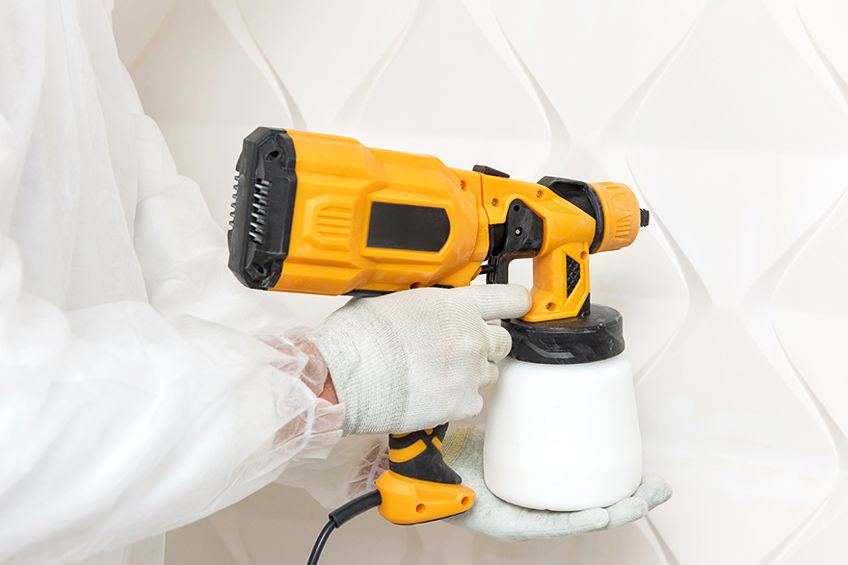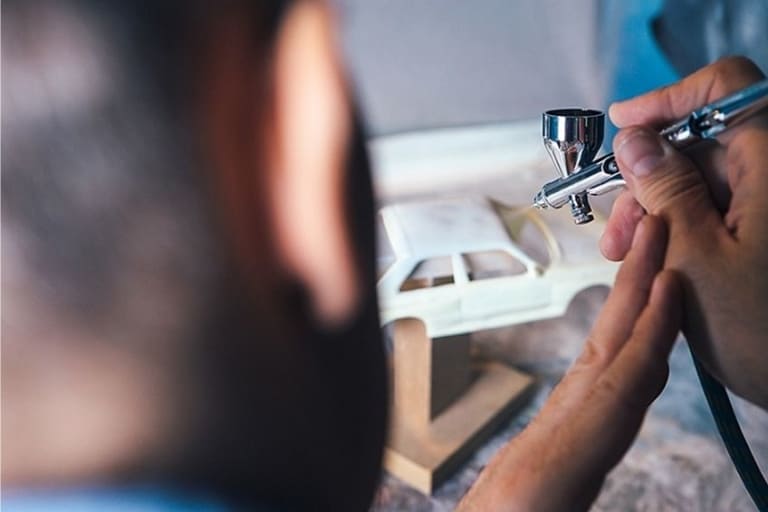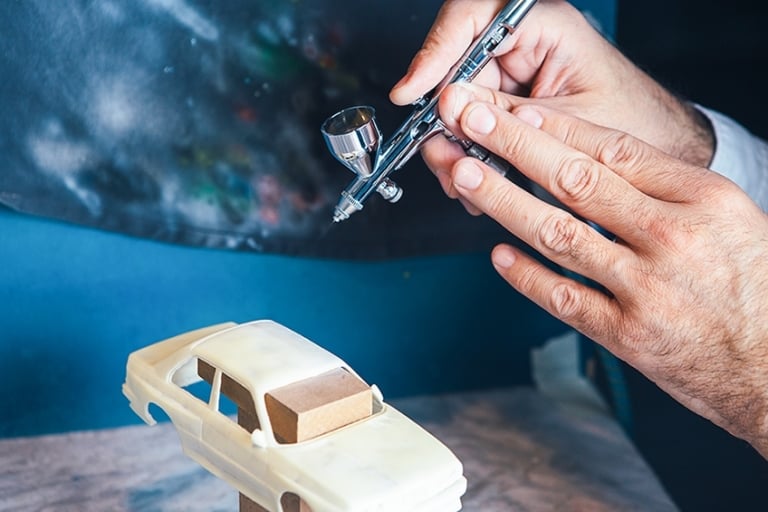Best Airless Paint Sprayer – An Exploration of the Best Airless Paint Guns
Disclosure: There are some affiliate links below and I may receive commissions for purchases made through links in this post, at now additional cost for you.
Getting started in paint spraying can be daunting, to say the least. There are so many things you need to consider especially if space comes at a premium or you’re on a budget. Paint sprayers often require a compressor or turbine to create pressure that atomizes the paint allowing you to spray it onto the surface of your choosing. There is a way around compressors, turbines, pressure consistency and paint feeds though. Electric paint sprayers are a fairly new concept, and they offer impressive performance with very few drawbacks.
Table of Contents
- 1 What Are Airless Paint Sprayers?
- 2 What are the Pros and Cons of Using Airless Sprayers?
- 3 What’s the Difference Between HVLP and LVLP Sprayers?
- 4 Our Recommendations for the Best Airless Paint Sprayers
- 5 What to Look for in an Airless Paint Sprayer
- 6 Tips and Tricks for Using an Airless paint sprayer
- 7 How to Use and Clean an Airless Paint Sprayer
- 8 Frequently Asked Questions
What Are Airless Paint Sprayers?
If you are an avid crafter you have probably seen or heard of conventional air-fed paint sprayers before. They can be challenging to come by especially if you are low on space, not to mention that compressors and turbines take some time to spool up and the noise they make.
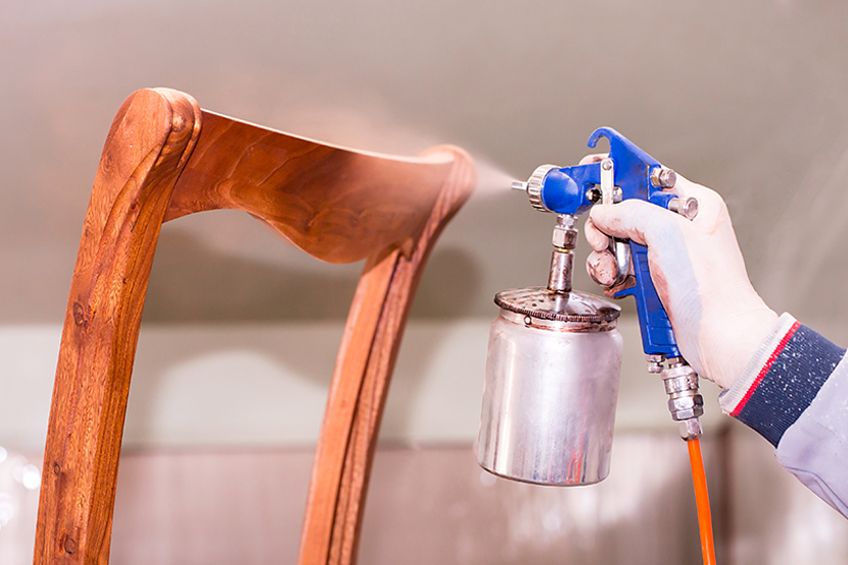
Airless paint sprayers are a great alternative, requiring less space to operate, store, and clean. There are also fewer components to be purchased and you have the bonus of not being restricted by an airline as hoses can get tangled, pinched, and trip you up if your focus is elsewhere.
How do Airless Sprayers Work?
At this point, you could be wondering how electric sprayers create air pressure if they don’t have to use forced air induction devices like a compressor or turbine. Surprisingly the answer is quite simple, airless paint sprayers essentially work via the use of an internal piston or impeller pump which then pressurize the paint in the canister attached to the paint sprayer, allowing the paint to be atomized as it travels through the paint sprayers nozzle.
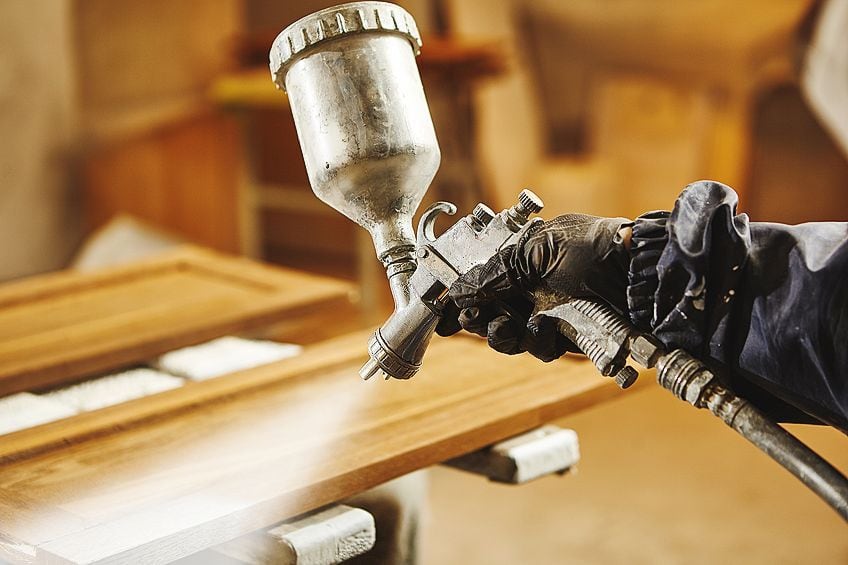
The impeller is located inside the spray gun module, which means that instead of having a paint reservoir/canister, air hose, and compressor you typically have only one device to manage. This does depend on the type of sprayer you purchase though, the type of sprayer we described above are known as “all in one” units which are most commonly used for crafting. There are others available which pump the paint to your spray gun from an independent canister, these types of electric sprayers have a pump unit that sucks up paint and feeds it into your spray gun via a hose much like a conventional sprayer.
These are great when you need to cover large workpieces you could easily use a sprayer that uses an independent impeller unit to spray an entire house if the mood took you.
What Can You Use an Airless Sprayer for?
There are many advantages to using an airless paint sprayer compared to a conventional paint sprayer. One of the most obvious advantages of these devices is having more consistent air pressure while operating your spray gun, this means you avoid orange peel and splatter due to pain that cannot atomize completely which can ruin your workpiece. This is why even some of the best airless paint sprayers are used on bigger projects and even applications outside of DIY crafting and woodwork.

A good example of these uses is spraying large workpieces like houses and rooftops. Logistically, using a conventional paint sprayer that relies on a turbine or an impeller for air pressure can be tedious especially when you need to move around a lot. Air feed lines are typically not that long, and although you can have an extra-long hose created for such applications you might need to increase the size and viscosity of your air supply to ensure consistent air pressure throughout your workday.
This is made even more challenging if you are working on an elevated surface and your air supply is ground level, where conventional paint sprayers now need to fight gravity and award angles, airless paint sprayers effortlessly feed the paint to your spray gun giving you’re the confidence and peace of mind to focus on the task at hand. Airless paint sprayers aren’t exclusively for our outdoor use either, they can be used in closed environments too, but you should always ensure the space is well ventilated during the painting process.
Many professionals prefer using airless paint sprayers to paint household interiors because they are easier to move from room to room compared to a sprayer that requires compressed air to operate.
It’s easy to see why, compared to wheeling around a compressor or turbine you simply plug in your electric pump, pop the hose into your paint canister, connect the pump to your spray gun and you’re good to go. No longer are you limited by air capacity or output, have fewer components to clean, and the pace of your work is limited only by your ambition.
What are the Pros and Cons of Using Airless Sprayers?
An airless sprayer can be one of the best investments if you are spraying large surfaces often, this is why they are so popular in commercial applications. There are several reasons professionals in both the construction and crafting community prefer these sprayers over conventional ones, but that doesn’t mean they’re the right tool for every job. Let’s have a look at some of the advantages and disadvantages the airless sprayer presents.
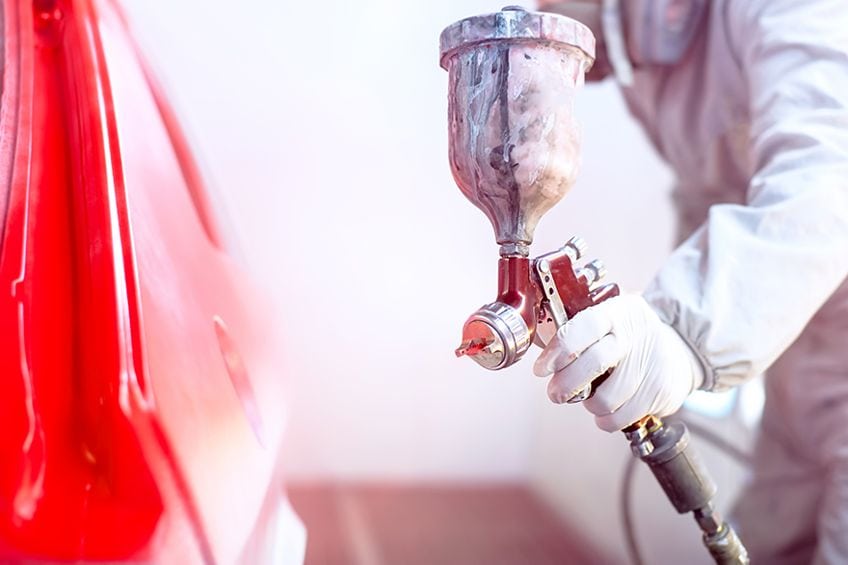
The Advantages of Using an Airless Paint Gun
Here are some of the advantages of working with an airless sprayer compared to a compressed air unit. You will notice the benefits stretch far beyond not having to deal with those air hoses tripping you up while you work.
Speed
is the name of the game when it comes to commercial spray painting. If you need to cover a client’s home in a day or two, you don’t want to be tripping over air hoses and lugging a compressor or turbine around the property.
Electric pumps are lighter, take less time to set up, and provide consistent viscosity regardless of angle or elevation.
Versatility
is important in any professional paint spraying application. Having one device that can do everything instead of four or five different machines you need to transport, store, and maintain is critical. Airless sprayers can be repurposed for a variety of applications such as weatherproof coatings for roofing and even UV coatings for furniture and plastics.
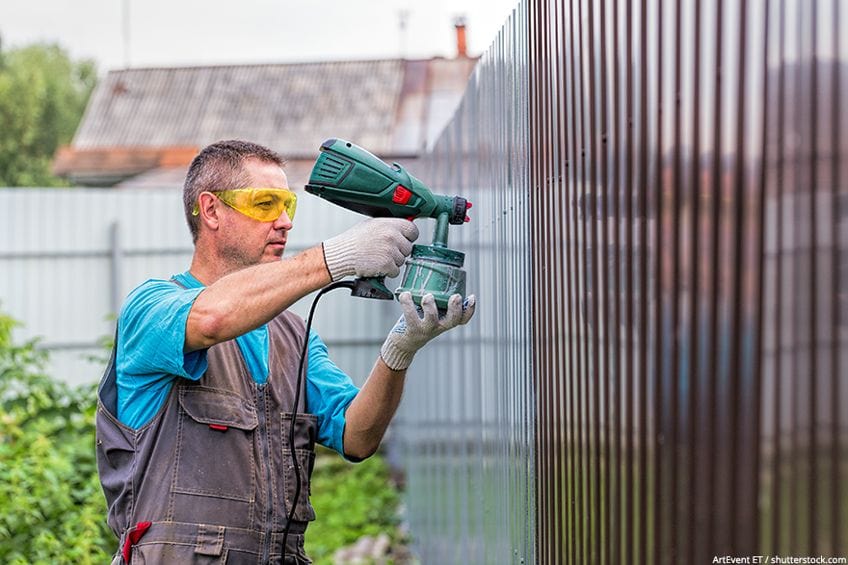
Quality
of work is arguably the most important aspect of any trade. Whether you do a good job, or a bad job can often mean the difference between getting your services recommended or not. This being said you need a paint sprayer that’s as consistent and reliable as you are. An airless sprayer provides consistent coatings and paint pressure throughout its use and requires minimal upkeep to do so.
Control
is the fundamental aspect of any great craftsman. Sure, you can control your hand but if your sprayer isn’t on the same page as you it can lead to a disaster. Airless sprayers allow you to control paint fluid pressure and spray pattern completely, therefore with the variable of air pressure removed from the equation you have absolute control over your spray gun.
Now that you know what some of the disadvantages are let shave a look at some of the more positive aspects of this type of sprayer and how they can save you some time and effort on your future projects
The Disadvantages of Using an Airless Paint Gun
As brilliant as airless sprayers are, they are relegated to certain applications despite their versatility. Let’s have a look at some of the shortcomings these sprayers present in certain scenarios.
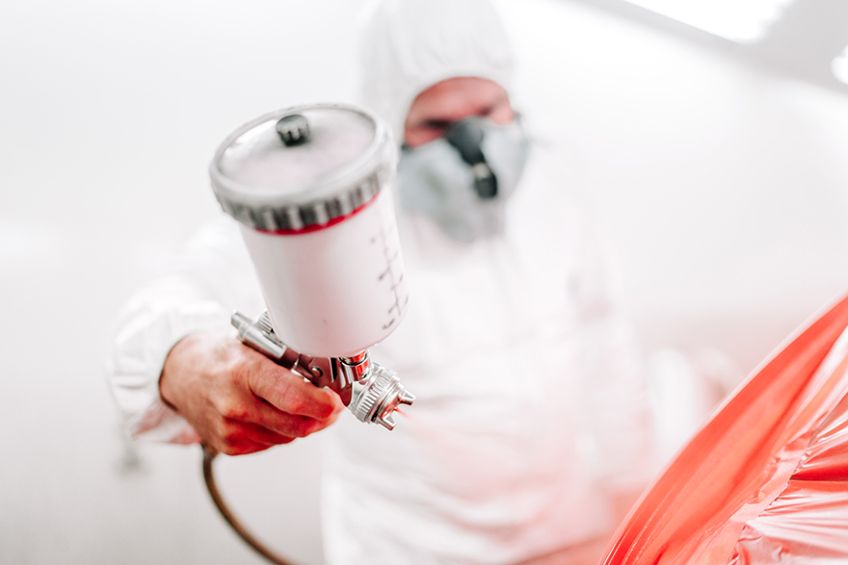
Maintenance
is a word that when uttered can cause one’s eyes to roll back involuntarily. It’s nobody’s favorite chore, but did you think you were going to get performance without any drawbacks? Well, you wanted the best airless paint sprayer, and it requires the best owner to do the best maintenance possible. Cleaning out the spray gun, paint feed and impeller pump can be tiresome, especially if you use it often, but would you rather clean a few lines or have to wait for a compressor to fill up?
Wastage
is largely considered to be a fading aspect in modern society, and although we’re still working out a lot of the kinks, we have made great progress. Not so with the airless sprayer, you see due to no pressurized air in the atomization process there tends to be a lot of stray paint particles in the air while you’re working.
This coupled with paint leftover in the line once you’ve completed your job adds up to a lot of wastage.
Setting Up
can be annoying no matter what it is you’re going to do. Even ironing your clothes can be a mind-numbing exercise when you aren’t in the mood, but you’re thankful to your past self for doing it the next day. The same goes for setting up airless sprayers, it can seem like a chore when you’re preparing your unit for a small job, but you’ll thank your good conscience for developing the habit when working on larger jobs.

What’s the Difference Between HVLP and LVLP Sprayers?
Choosing a paint sprayer can be tough especially when you don’t understand which would be best for your specific needs. Considering that there are hundreds of paint sprayers on the market today that all claim to be the best, we’ve gathered some facts about the two main types of paint sprayers you might come across so you can decide what suits you best.
HVLP Paint Sprayers
HVLP stands for high volume low pressure. These are the kinds of sprayers that usually use compressed air to operate. Essentially, compressed air Is pumped into your paint canister which forces the paint into the nozzle of your paint gun for atomization which eventually lands up on the surface you are painting. The “high volume” part refers to how HVLP sprayers atomize the paint in high volume using relatively low pressure.
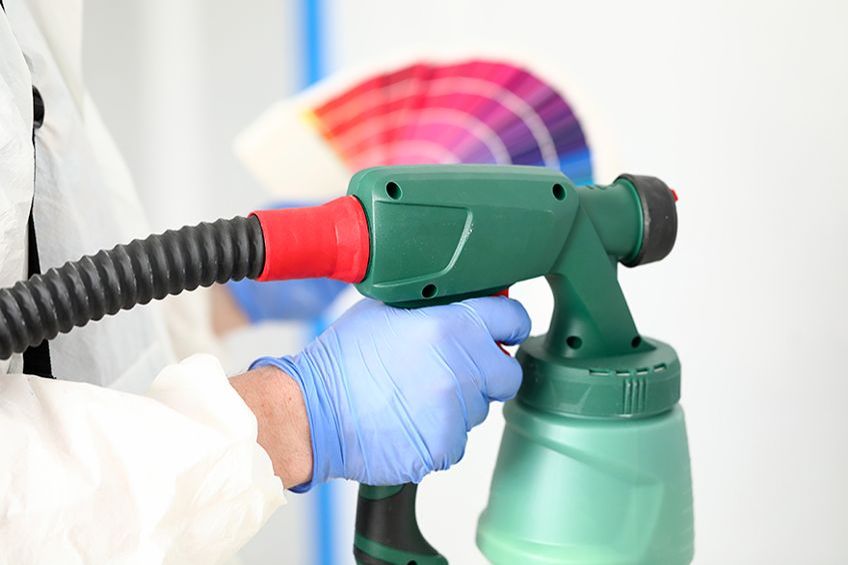
You will need an air compressor or a turbine to operate these types of sprayers, which means overall the setup can cost you quite a bit if you don’t already have either. They also tend to use more pressure to set the paint down of the surface you are spraying than LVLP sprayers. These types of spray painters typically take up a lot of space, but you then have the advantage of added air pressure which you can use to spray paint with thicker consistencies such as latex-based paints.
This is great for spraying protective coatings especially if you’re working in a high output environment or have multiple projects you need to spray on the same day for example.
LVLP Paint Sprayers
LVLP stands for low volume low pressure. The key difference between this type of sprayer and HLVP sprayers is that it operates at roughly ten PSI less pressure at the nozzle than the latter. Typically, they still operate with compressed air via either a compressor or turbine so there’s a good chance you will still encounter some of the issues apparent with HLVP paint sprayers. The “low volume” is most prominent in the spraying process with this type of sprayer as it will produce a finite amount of spray with each pull of the trigger, meaning you’d have to work this type of sprayer to generate any sort of overspray.
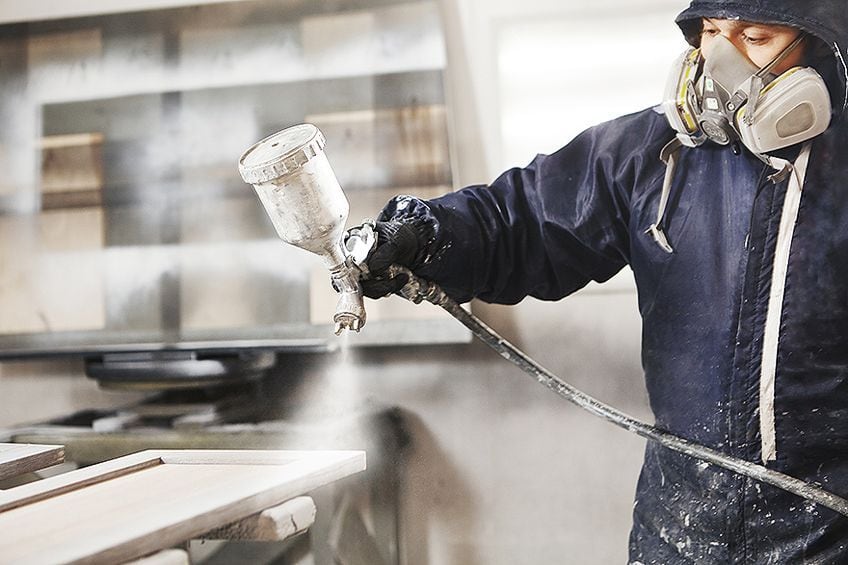
Overall, this is great in some applications because it widens your margin for error when spraying large surfaces, but it does leave a bit to be desired in the spray pattern department. Due to the low volume aspect of these sprayers, the spray tips are often less adjustable than that of HVLP sprayers. Choosing a paint sprayer has a lot to do with what you intend to do. HVLP sprayers have more PSI out the nozzle, however, if this is something you need (or want) you’re going to have to live with the possibility of splatter and the need for a decently powerful compressor or turbine.
If you opt for the LVLP prayer you may be able to get away with a less powerful compressor since it runs on relatively low pressure and volume, which could save you a pretty penny if your workload isn’t conducive to an HVLP sprayer.
Our Recommendations for the Best Airless Paint Sprayers
Choosing your first airless paint gun can be a difficult process. We recommend you keep in mind what you want to do, for example, ask yourself if you really need a super-powerful machine, or a pump that big? Would a handheld sprayer be better? How much storage space do you have? With those things to consider, here are three of the best airless sprayers we could find.

Best Overall Airless Sprayer: GRACO Magnum X5 Stand Airless Sprayer
Maybe you’re bringing in the groceries and see the paint peeling off your front wall, or you simply can’t stand the color of your bedroom any longer. Either way, something needs to be done and your trusty brush and roller combination simply won’t cut it this time. The Graco Magnum X5 is our top pick for all of your tall order painting needs, in fact, it might be the best professional paint sprayer out there at the moment! The Graco is packing a modest half-horsepower electric motor that will process just about any paint or coating you can think of including gloss, enamel, vinyl, and latex.
- Fully adjustable pressure and paint flow for easy use
- Allows you to spray unthinned paint at a high pressure
- A suction tube allows you to spray paint straight from the container
Once you have selected your ammunition simply point the Graco at the surface you’re painting and let it do the rest, in fact, it doesn’t matter if your target is on the second floor or the roof, the Graco’s paint feed comes standard at 25 feet and can be upgraded to 75 feet if you don’t feel like moving it once in a while. Although not the most expensive airless sprayer on the market today it does make you feel a bit special especially the way the 100 percent cast metal spray gun sits in your hand.
It’s not all show and no go either, pushing out a whopping 3000 PSI makes the Graco rather beefy compared to other paint sprayers of its size and in its price range. The cherry on top for us has to be how easy it is to clean, in fact, you can simply hook up your garden hose flush the system completely, or if your nozzle has packed up simply remove it, turn it around and give the trigger a squeeze!
PROS
- Powerful 3000PSI output
- Easy to use
- Portable
- Premium finish
- Easy to clean and has a reversible nozzle
- 25-foot hose included
CONS
- No wheels for ease of movement
- Longer hose much be purchased
- Pump height is not adjustable
- Needs to be cleaned often
Best Performance Airless Sprayer: GRACO Magnum X7 Cart Airless Paint Sprayer
Everyone has someone that just that little bit better than them in every single way, whether it’s your older sibling or your gym buddy. The Graco Magnum X7 is the better in this instance, making the X5 pale by comparison in just about every department. This model’s most noticeable difference is that it has comes attached to a frame equipped with wheels which means your days of carrying around a pump everywhere you need to be are over! However, there is much more to the X7 than just aesthetic and mobility upgrades.
- Fully adjustable pressure to give you ultimate control of paint flow
- Stainless Steel Piston Pump allows you to spray paint unthinned
- PowerFlush Adapter connects to a garden hose for fast cleaning
Powered by a five-eighths horsepower electric motor it packs slightly more punch than the X5 model and even comes packing a slightly larger tip to use all of that extra power for better coverage of your workpiece. One feature we found to be particularly helpful is the adjustable height of the feed tube which is just perfect for when you want the paint directly from the bucket. All of this does make the X7 considerably more expensive than the previous model we looked at but for the convenience, these upgrades provide you definitely get what you pay for.
This unit is perfect for anyone looking to spray a large building, and we aren’t talking about a small cottage near the countryside. The Graco X7 might come standard with a 25-foot hose, but it will comfortably support a 100-foot extension without protest. This machine is perfectly suited for the professional home renovator and the weekend warrior being a price range most would consider attainable. This machine is also cleanable via hose attachment making wrapping up storage a breeze. You won’t be left wanting much if you choose this airless sprayer.
PROS
- Powerful motor
- Takes a 100-foot paint hose
- Adjustable height for paint feed
- Comes on a wheeled frame
- Can be cleaned via the hose attachment
- Larger spray diameter than the previous model
CONS
- Marginally more expensive than the previous model
- No pressure reading for paint supply
- Requires cleaning after every usage
- Can be difficult to store due to the wheeled frame
Best Price Airless Sprayer: WAGNER Flexio 590
Not in the business of moving mountains? Don’t think that painting an entire home on your own is up to your alley? Well, we have just the spray painter for you, the Flexio 590 finds its way onto our list for the DIY and crafting enthusiasts wanting to take their creative game to the next level. This is a completely handheld unit with no auxiliary pump or long paint supply lines to work your way around, so everything is right in front of you and exactly where you left it. Packing a total weight of just two-point one pounds it does feel like holding the world’s lightest arsenal in your hand.
- A convenient handheld HVLP paint sprayer for a range of projects
- Has two different nozzle sizes for work on large and small scales
- Completely adjustable paint flow that is easy to use
It can take on materials with a higher viscosity although you will be pushing it a bit out of its comfort zone in doing so. If you do choose to go this route you will find its nine different spray pressure settings more than adequate for handling all kinds of primers and paints, and the best part is you won’t have to wear earmuffs while you work. The Flexio claims to be 50 percent quieter than most of its leading competitors and even features vibration compensators so you don’t develop carpal tunnel while you work.
This particular model also comes with a variety of finishing nozzles for reaching those tiny nooks that would otherwise be ignored or brushed over. This unit might not be as powerful or have as large a capacity as the others on our list, but it is fairly versatile and does not take up nearly as much space or require nearly as much upkeep as the other models.
Being easily cleanable, light, portable, easy to use, versatile, and electric makes the Flexio a serious contender for the best professional airless sprayer, and we think that the team over at Wagner knew exactly which gap in the market they were aiming for when they designed this little box if dynamite.
PROS
- Compact design
- Easy to clean and maintain
- Easy to store and handle
- Multiple spray speeds
- All in one handheld unit
- Finishing spray tips for detailed work
CONS
- Low on power
- Holding a gun and canister can be tiring
- Low paint capacity compared to other units
- The paint canister can be hard to remove as it is too smooth
What to Look for in an Airless Paint Sprayer
Before you go out and buy what you perceive to be the best professional paint sprayer it’s best to take stock of a few things. There are many factors to consider when choosing a sprayer and many people overlook them in the interest of “buying something that can do everything” which is not a bad choice objectively but cost you a lot more in the long run. Let’s have a look that some of the things we feel everyone should consider whether they are buying their first or last airless paint gun.
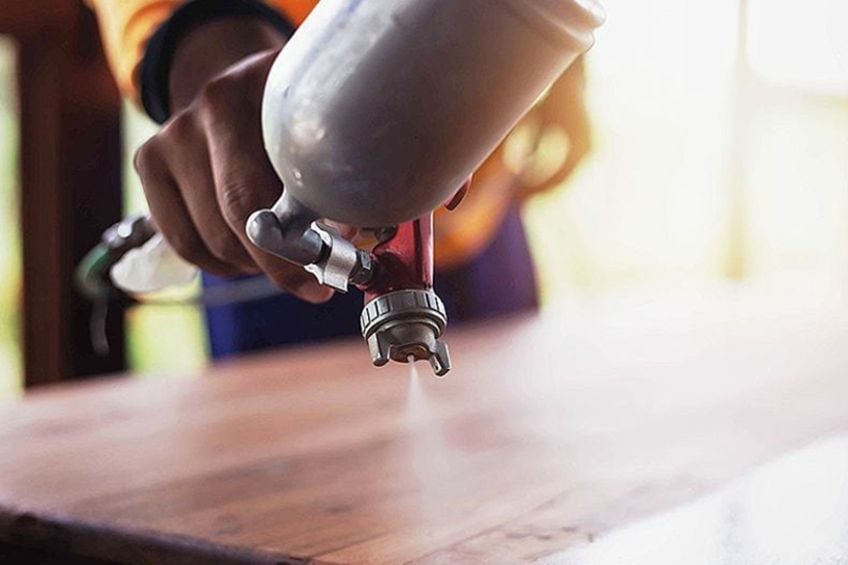
Size
There are certain instances where bigger doesn’t always mean better. Although, it does depend on what the need is, and if you know you definitely won’t be using an industrial-grade machine for its intended purpose you should consider saving the money.
Remember airless sprayers require regular maintenance even when they aren’t being used, so buying a machine that’s far larger than your occupation or workload warrants can backfire pretty quickly.
Imagine turning your sprayer on only to find that the piston has been caked over by primer that’s been in the system since last summer? In the same breath don’t undercompensate by purchasing and handheld sprayer if you will be painting property fences. Find that sweet spot for your needs and your pocket.
Hose Length
This is something you need to keep in mind if you are purchasing a sprayer with a separate intake unit. Many craftsmen overlook this point and end up having to make a second trip down to the hardware store, which is a minor inconvenience in the grand scheme of things but can be annoying especially when you are halfway up a ladder with your ready to work only to find that you have run out of hose.
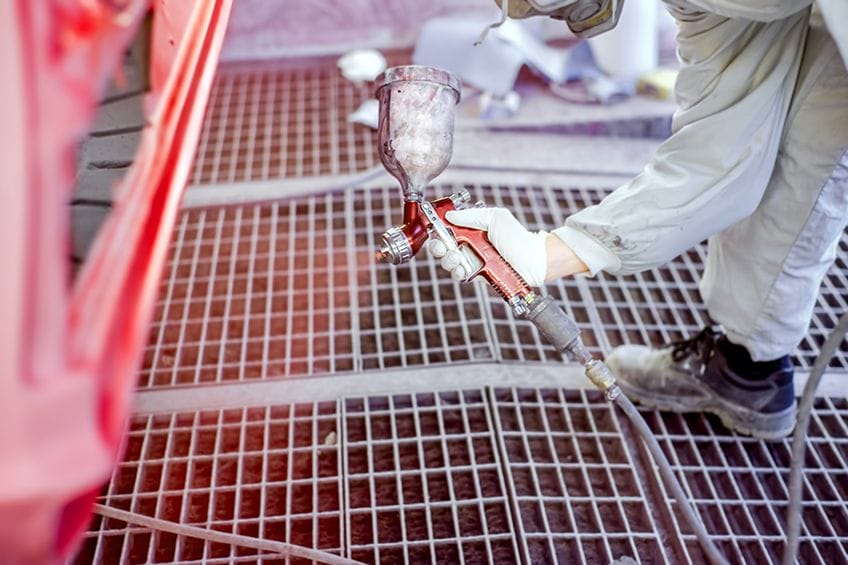
Always check the length of hose provided with your initial purchase, then make it your mission to find out what the maximum effective length of hose your unit can operate with. Again, you don’t want to be stuck with more hose than available space, but you don’t want to end up with too little either, so be realistic about what projects you will be tackling the most.
Nozzle and Spray Pattern Control
You may have noticed that the average airless paint gun comes standard with the ability to change your spray pattern either passively via a control knob or by changing the tip of the spray gun. This is a great way to ensure your spray gun works for a variety of jobs and applications although not all settings are equally as versatile or effective.
Choose a device that’s pressure settings and spray pattern adjustments are most conducive to the type of work you will be doing the most, as a matter of opinion if a machine has decent power, has a wide variety of spray patterns, is reasonably priced, and fits your application, you probably won’t be disappointed.
Tips and Tricks for Using an Airless paint sprayer
Here are a few tips and tricks for working everything from a high-end sprayer to a cheap airless paint sprayer. These tips are helpful to beginners and experienced craftsmen alike so keep them in mind and never forget safety first!

Choosing the Right Tip for the Job
Remember that you don’t have compressed air assisting in atomization, so your sprayer tip is extremely important when you are working with an electric sprayer. Always choose a spray tip with a lower spray rate than your sprayer to ensure maximum viscosity upon the paint entering the sprayer tip and ensure the fan rate of the tip is suited to the material you will be spraying.
This advice can seem a bit technical, but it will save countless hours of cleaning up overspray and unwanted splatter.
Prime Your Machine
Now that you and your workplace have been prepared you should ensure that your sprayer and pump are ready for action. Double-check the tip of your sprayer and the inlet of your pump to make sure that there are no caked-up blotches of paint blocking them. Once this is done, check that your paint feed hose is free of knots and that the intake pipe of your pump is at a decent depth in the paint container.
Learn to Overlap Your Strokes
Overlapping is a great technique to learn early on when you are getting to know your machine and practicing it can benefit you greatly in the long run. Your spray pattern should overlap with the last stroke you completed, compensating for any inconstancies in the paint application and giving you peace of mind that that you won’t need to go back in once you are done. It’s a simple trick but it will save you a lot of time and effort while giving your workpiece a higher quality finish once perfected. If you are unsure about how to do this, there are several tutorials available online with a step-by-step guide.
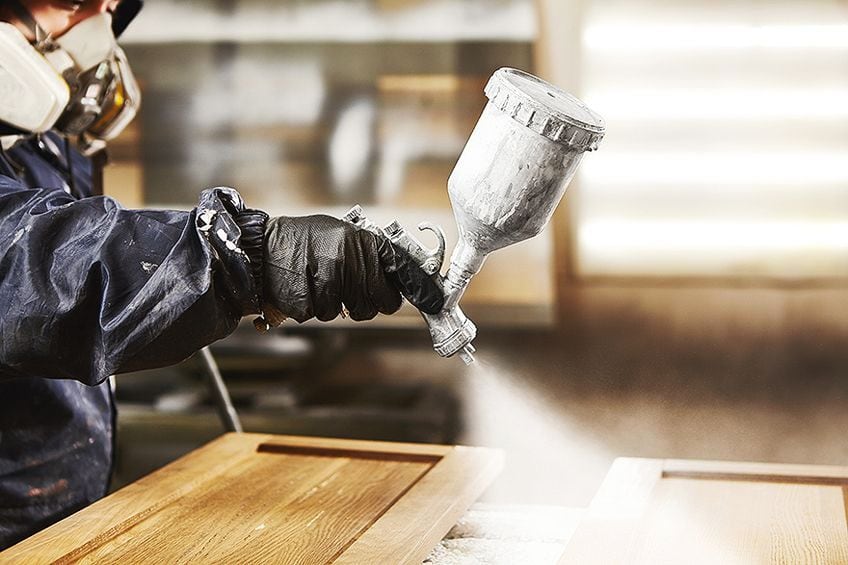
How to Use and Clean an Airless Paint Sprayer
We would like you to have a basic idea of how to use an airless sprayer if decide to go ahead and buy one, so here are some fundamentals if it’s going to be your first time using an airless sprayer. Nervous? Don’t be. These Sprayers are designed to be simple to use and easy to manage.
Prepare Your Paint
Considering that most airless sprayers have an independent intake pump that often connects directly to a paint container via an intake pipe, you should always ensure that the paint you will be using has been mixed on appropriately.
Check the manufacturer’s instructions (often on the label of the tub) for how the paint should be prepared.
Technique is Key
Okay so now that you have the right tool for the job you need to work on using it effectively. Paint sprayers, even cheap airless paint sprayers, are consistent machines that operate only as well they are designed to. The constant variable in any situation is your hand and trigger finger, so practice keeping your arm still and only spraying with your wrist. Your goal should be aiming for one fluid movement in either direction while remaining about 11 inches away from your workpiece. Practice makes perfect and if you are used to working with compressed air the learning curve can be steep if you aren’t patient.
Prepare Your Workspace
Airless sprayers have a reputation for producing a lot of overspray so you might want to lay down a tarp or two just so everything other than your workpiece has is protected from any stray particles. Also, make sure you are wearing protective clothing as oil and latex paints can be troublesome to remove.
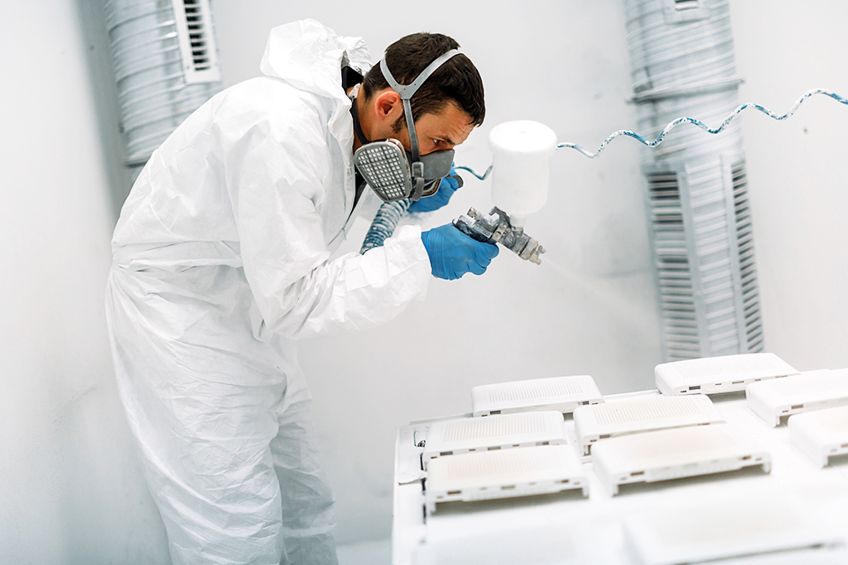
Start Spraying!
Okay, this Is it. Select the pressure setting and spray pattern you would like to use and start spraying. Remember that it’s all in the wrist, your objective is to maximize coverage while keeping distance and trigger pressure as consistent as possible. Don’t be discouraged if it takes you a few tries and remembers that practice makes perfect.
We hope that you enjoy your new airless sprayer and that the tips and tricks above help to maximize productivity and take your crafting skills to the next level. Always keep in mind that everyone has been a beginner so if you have a question don’t hesitate to ask!
Frequently Asked Questions
Do Airless Sprayers Create Overspray?
This is not your typical yes or no question. Airless sprayers do tend to create more overspray statistically compared to conventual pneumatic sprayers due to the amount of paint being forced through the tip of the spray gun. However, knowing which tips to use with which gun can nullify this issue completely.
Do Airless Sprayers Use More Paint?
Yes, according to many sources airless sprayers use on average 40 percent more paint than using a brush or a roller. This is quite a bit of paint even compared to pneumatic sprayers which typically use up to 20 percent more than the brush or roller applicators.
Are Airless Paint Sprayers Worth it?
This is entirely dependent on the application. Airless sprayers work the best when there is a lot of work to be done and you need it done quickly. Lots of home renovators and contractors use airless sprayers due to the time-sensitive nature of their occupation.

